Yoga for a Healthy Lower Back (22 page)
Read Yoga for a Healthy Lower Back Online
Authors: Liz Owen

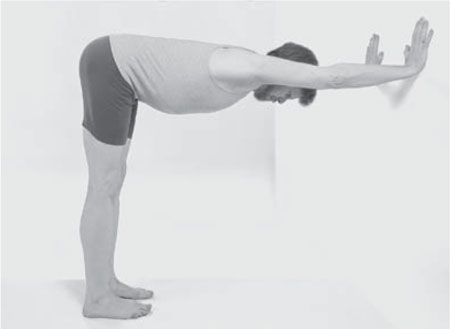
FIG. 3.19
Slowly stretch your legs straight one at a time, as you did in the forward bend experiment we practiced earlier in
this chapter
. Keep your sit bones lifting, and be sensitive to any shifts in your hips and lower back. If your sacrum is comfortable, stretch your legs completely straight, otherwise keep a slight bend in your knees so you don't overround and strain your sacral joints or your lumbar spine. Try turning your toes inward to feel even more broadening of your sacral band.
Come out of Half Forward Bend Pose by bending your knees and walking toward the wall. Keep your hands at the wall until you are once again standing upright.
If Half Forward Bend Pose at a wall is comfortable for your sacral band, try a slightly deeper version by placing your hands on the seat of a chair and walking back into the pose until your hips are right over your feet and your trunk is long. You'll enjoy more stretch all along your back body and a deeper bend at your hips.
Standing Forward Bend Pose
Stretch | Uttanasana
When Half Forward Bend Pose is comfortable for your sacrum, you can practice full Standing Forward Bend Pose.
Stand with your feet hips' distance apart with your legs, trunk, and
spine elongating upward in Mountain Pose. Place your hands on your hips and fold from your hips, drawing your trunk first forward and then toward the floor. While moving into the pose, place your hands on your thighs for extra support and bend your knees slightly to make folding at your hips easier. Place your hands on the floor (
fig. 3.20
), or on blocks or a chair if they don't reach the floor. Take your trunk down only as far as your sacrum very comfortably allows. Slowly straighten your legs. Remember to turn your upper thighs inward, and your toes too, if that was a good feeling in Half Forward Bend Pose, to help spread your sacral joints.
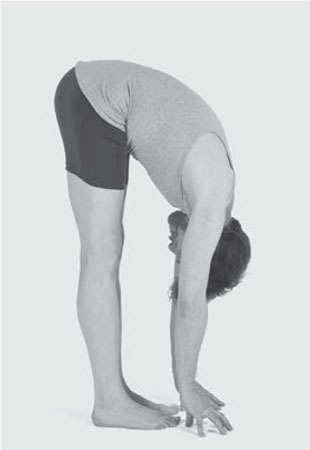
FIG. 3.20
Standing Forward Bend elongates all the muscles of the back body, and it's especially helpful for releasing a tight sacral band. If your sacral joints are weak or imbalanced, proceed with caution. You'll want to keep the back of your hips in alignment as much as possible, bend your knees, and pay special attention to lifting your sit bones upward as you fold forward. This will help your sacral joints follow the forward movement of your hips so your lower back holds its integrity as you bend.
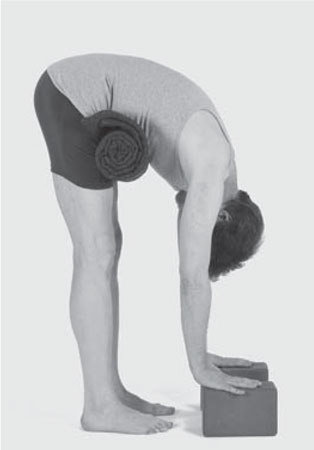
FIG. 3.21
Stay in Standing Forward Bend Pose for a few breaths. Let your hamstrings release any amount possible, and enjoy the feeling of your back body stretching from your heels, over your bent hips, and all the way through the crown of your head. Softly inhale, and come out of the pose with your hands on your hips or thighs, whichever is more comfortable for you. Stand with your eyes closed for a few moments and visualize the energy at your Svadhisthana and Manipura chakras stimulated and alive through the massage they just received. Visualize the webs of your sacral ligaments and the musculature of your back hips opening and “breathing,” drinking in fresh energy from your rejuvenated chakras and a wash of fresh blood to help them become healthy.
Variation: Decompressing Forward Bend
Hold a rolled blanket or a bolster along the top of your thighs. Folding your trunk at your hips, come into Standing Forward Bend. Release your arms toward the floor, placing your hands on blocks, or hold your elbows and let your arms descend.
Your front ribs should rest on the roll (
fig. 3.21
). If they don't, or if the roll slips toward the floor, bend your knees until you can hold the roll between your thighs and trunk. This is soothing and relaxing for sacral compression because it gently elongates the musculature of the back of the hips and the lower back.
Restorative Twist Pose
Rest | Parshva Balasana
Sit on the floor with your legs straight forward. Lean to your right, bend your knees, and shift your shins and feet to your outer left hip. Rest your hips evenly on the floor. If you have a knee or hip issue that stops you from resting both hips on the floor, sit on a folded blanket. Separate your knees and let your legs relax.
Place a bolster at a ninety-degree angle to your right hip. Place your hands on either side of the bolster and gently turn your torso to the right so it is centered on the bolster. Now lay your torso down onto the bolster. Turn your head to the right, to give your neck a gentle stretch, and relax. Let your arms rest along the floor.
10
Ahh . . . that should feel good! This is a restorative pose, which means that your body is receiving a gentle, opening stretch in a completely supported position. In other words, right now you have no work to do; just let your body completely let go and relax (
fig. 3.22
).
Breathe into your sacrum and feel it broaden. Breathe into your spinal muscles and feel them gently elongate along the bolster, bringing your spine into a soft twist from your lower back all the way up to your neck. You can turn your head to the left if that makes your neck more comfortable. Stay in Restorative Twist Pose for as long as you are comfortable, then come out by pressing your hands into the floor to lift your spine up. Swing your shins over to the right side of your body, move the bolster to your left side, and repeat the twist to your left.
Restorative Twist Pose gently stimulates your whole lower back. The myofascia releases along diagonal lines, lengthening the deep hip musculature and the webs of ligaments that cover your sacrumâimagine being able to hold a spider's web and gently elongate it diagonally. The Ida, Pingala, and Sushumna, the energy pathways we've discussed throughout this chapter, are opened and stimulated in this pose, resulting in an easy, unrestricted flow of energy from the Muladhara chakra at the base of your hips all the way up your spine to the Sahasrara chakra at the crown of your head. No wonder this pose feels so nourishing and enlivening!
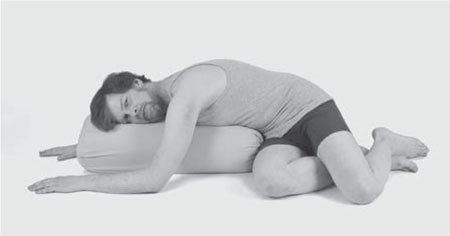
FIG. 3.22
Deep Relaxation: Rest into the Earth
Rest | Shavasana Variation 2
Now it's time to completely let go and rest your sacrum into the support of the earth. You'll need a bolster, one or two folded blankets, and a rolled towel. Have your eye pillow handy if you like to rest your eyes.
Place your bolster across your mat and sit behind it. Drape your legs over your bolster so it is directly under your knees. Lie back onto your elbows and press your forearms down into the floor to elongate your trunk. Slowly, vertebra by vertebra, rest your upper body onto your mat (or a blanket for an even softer experience). Slide your hands under your upper thighs and buttocks and draw them out to the sides to create the feeling that your sit bones and sacral joints are spreading apart from each other. Let your feet rest with your toes pointing slightly outward (
fig. 3.23
). Be sure your heels are resting on the floor; place a folded blanket underneath them if they are not.
If your lower back is uncomfortable when you lie down in this position, try one of these variations and see if you can find the support it needs to relax:
â¢Â  If your sacral joints feel loose or weak and your sacrum feels too “flat” against the floor, place a rolled towel under the top of your sacral band, adjusting the height of the roll for comfort. This gives direct support to your lower back, helping the muscles and myofascia to relax and restoring your lower back's natural, gentle curve.
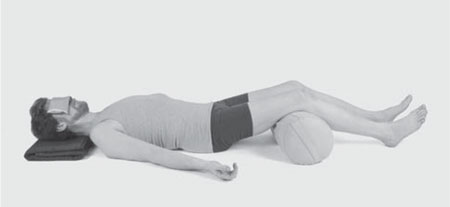
FIG. 3.23
â¢Â  If your lower back feels tight or compressed, place a folded blanket under your hips. This elongates your lower back.
After you've gotten into a position of absolute comfort in your sacrum, rest your head on a folded or rolled blanket. Place your eye pillow gently across your eyes, feeling your eyes calming down and softening inward. Finally, rest your arms on the floor, angled slightly away from your body so your shoulders roll gently down into the support of the earth. Rest your palms facing up or down, whichever is more comfortable for you.
Relax your throat and neck, and feel the center of your skull resting into your mat or blanket. Let go in your jaw, feeling it slightly open, and release your facial muscles out to the sides of your face and down toward the floor. Take time here and use a few breaths to move your attention from the body's outermost layer, your skin, to the deep layers of your facial muscles; you will feel your face losing its everyday expressions and becoming neutral and passive. Creating a feeling of neutrality in your body will help your mind come away from its attachment to thoughts so it is neither pulled toward positive thoughts nor pushed away from negative ones. Feel your mind becoming balanced and centered, a witness to thoughts without judging or being affected by them. Feel your mind becoming impartial to what it finds as it observes your body, and ready yourself to go even farther inward in meditation.
In the Yoga Sutras of Patanjali, sutra 1.33 states, “The mind becomes clear and serene when the qualities of the heart are cultivated: Friendliness toward the joyful, compassion toward the suffering, happiness toward the pure, and impartiality toward the impure.”
11
Take a few minutes to meditate on these qualities and how they live in your heart. When your mind moves into a neutral state, you can look within and see what exists there without making a judgment about yourself. Can you find friendliness, compassion, happiness, and impartiality toward yourself? Now, can you direct these qualities toward your tight, overstretched, weak, or achy sacrum? Cultivating these qualities can help you deal more easily with discomfort and painâin your sacrum and beyond. That's one big benefit. Another is that once you treat yourself with friendliness, compassion, happiness, and impartiality, you can engage with the world surrounded by those same qualities. Yoga practice helps you live comfortably in your own body and engage with others with a benevolent, serene countenance.
